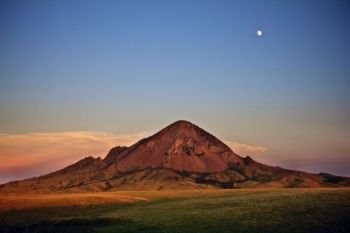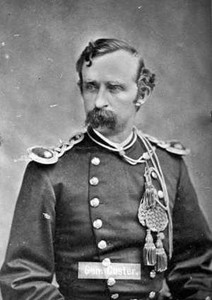Bear Butte
Introduction
Text-to-speech Audio
Images
Bear Butte as it stands today.

George Custer is best known for his ill-advised offensive that led to his death, but he was also an experienced officer and explorer.

Backstory and Context
Text-to-speech Audio
Within the Black Hills mountain range of South Dakota is the rock formation known as Bear Butte. This geological marvel is recognized as a National Historic Landmark and is also home to a state park. The site continues to serve as a sacred religious site to local Native American tribes as well. Standing at an elevation of 4,426 feet, Bear Butte was formed from a welling of magma that failed to crack through the earth’s crust which hardened into the mountain that stands today.
The site became well-known to settlers of European descent after George A. Custer led an expedition to the Black Hills in 1874. Custer was sent out in search for gold and a place to set a military fort. After he found gold in the Black Hills, Bear Butte became a reference point when following Custer’s trail. This discovery brought many to the area and led to the government's decision to break the treaty of 1868 that declared that the Black Hills belonged to the Sioux. A gold rush followed Custer’s find, yet relatively little gold was found in the Black Hills.
When prospectors violated the treaty of 1868, the Sioux asked for the government to enforce their treaty. When the government failed to prevent encroachment on Sioux lands, some Native tribes retaliated against the settlers. This conflict led to the U.S. Government confiscating the land in 1877 and forcibly relocating the Sioux.
Before the expedition of the Black Hills, the Bovee family were area settlers and traders. Ezra Bovee homesteaded at the base of Bear Butte. As legal owners of the site, the Bovee family were approached by the local tribes and granted permission for tribal members to continue to hold religious ceremonies at the mountain. From this constant exposure to the mountain and ceremonies, the Bovee family urged for the site to be turned into a national park.
Bear Butte became a state park in 1961. Today measures are taken to protect the religious rights of the tribes who visit the mountain. Visitors are advised to not touch religious artifacts and stay off restricted land. Some religious ceremonies are available for public viewing, and the site also holds hiking trails for its visitors. With the recent increase in people and overall development to the area, there are concerns from the local tribes. One of these concerns is noise, with the tribes stating that volume of traffic in the summer occasionally breaks the peace of religious ceremonies and harmony of the mountain.
Sources
2. Bear Butte State Park. Black Hills and Badlands. . Accessed March 17, 2019. https://www.Blackhillsbadlands.com/parks-monuments/bear-butte-state-park.
3. Black Hills Gold Rush. The Black Hills. . Accessed March 21, 2019. http://www.theBlackhills.com/Black-hills-gold-rush/.
4. 1874 Custer Expedition to the Black Hills. Black Hills Visitor. . Accessed March 21, 2019. https://Blackhillsvisitor.com/learn/1874-custer-expedition-to-the-Black-hills/.
5. George Armstrong Custer. History. November 09, 2009. Accessed March 21, 2019. https://www.history.com/topics/native-american-history/george-armstrong-custer.
6. Mato Paha Bear Butte. Akta Lakota Museum Cultural Center. . Accessed March 17, 2019. http://aktalakota.stjo.org/site/News2?page=NewsArticle&id=8999.
7. Photo of Bear Butte. South Dakota Magazine. Accessed April 3, 2019. https://www.southdakotamagazine.com/bear-butte-begeman.
8. Photo of George Custer. Black Hills Visitor. .Accessed April 3, 2019. https://Blackhillsvisitor.com/learn/1874-custer-expedition-to-the-Black-hills/.
